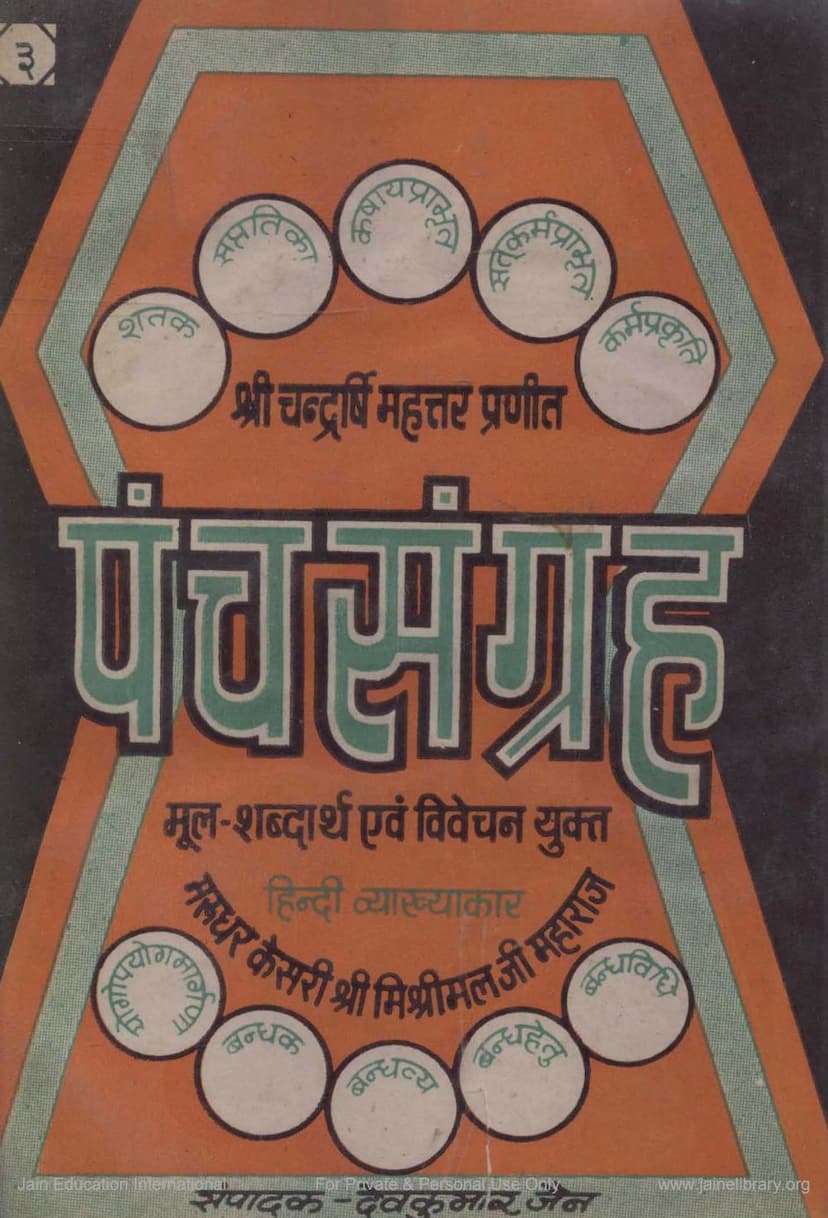Panchsangraha Part 03
Added to library: September 2, 2025

Summary
This text is the third part of the "Panchsangraha" (Five Compilations/Collections) by Acharya Chandrashi Mahattar, with a Hindi commentary by the revered Marudhar Kesari Shri Mishrimallji Maharaj and compiled by Devkumar Jain Shastri. Published by Acharya Shri Raghunath Jain Shodh Sansthan, Jodhpur, this volume focuses on the "Bandhyavyapraroopana Adhikar" (Chapter on the Nature of Bondable Entities), which deals with the principles of karmic bondage in Jain philosophy.
Key themes and content:
- Centrality of Karmasiddhanta: The book emphasizes that understanding the karmic doctrine (karmasiddhanta) is essential for comprehending Jain philosophy.
- The Soul and Karma: It explains that the soul, though inherently pure and powerful, wanders through the cycle of birth and death (samsara) due to its association with karma. Karma, being a subtle form of matter (pudgala), binds the soul through the soul's attachment and aversion (raag-dvesh).
- Nature of Karma: Unlike other philosophies that might attribute the cause of worldly diversity and suffering to God or other external factors, Jainism identifies karma as the primary cause, alongside the soul's own actions and intentions. Karma itself is inert (jada) but becomes powerful and binding when associated with the soul's passions.
- Importance of Panchsangraha: Along with "Karmagrantha," "Panchsangraha" is highlighted as a significant text in Jain karmic literature, providing a detailed exposition of various aspects of karma, including gunasthanas (stages of spiritual development), marganas (ways of life/existence), and the classifications of soul (jiva) and non-soul (ajiva).
- Commentary and Accessibility: The text acknowledges the complexity of the original Prakrit and Sanskrit texts and praises the efforts of Shri Mishrimallji Maharaj for undertaking the arduous task of creating a simple Hindi commentary, making this profound knowledge accessible to a wider audience. The preface also pays tribute to his dedication and vision, even in his advanced age.
- The "Bandhyavyapraroopana Adhikar": This specific chapter delves into what entities are bondable, i.e., what constitutes karma.
- Eight Principal Karmas (Mool Prakritis): The text systematically introduces the eight fundamental types of karma:
- Jnanaavarana (Knowledge-obscuring karma)
- Darshanaavarana (Perception-obscuring karma)
- Vedaniya (Feeling karma)
- Mohaniya (Delusion karma)
- Aayu (Age-determining karma)
- Naam (Body-making karma)
- Gotra (Status-determining karma)
- Antaraaya (Obstruction karma) The text explains the purpose of this specific order, linking the sequence of karmas to the development and obstruction of the soul's inherent qualities like knowledge and perception.
- Sub-Karmas (Uttar Prakritis): Following the introduction of the eight principal karmas, the text enumerates the sub-categories (uttara prakritis) for each, detailing their numbers and characteristics. This includes a comprehensive breakdown of each karma type, such as the five types of Jnanaavarana, the nine types of Darshanaavarana, the twenty-eight types of Mohaniya (further divided into sixteen kashayas and nine nokashayas, plus the three darshana moha prakritis), the four types of Aayu karma, the forty-two types of Naam karma, the two types of Gotra karma, and the five types of Antaraaya karma.
- Classifications of Karma: The text extensively categorizes karma based on various parameters, including:
- Dhrva-Bandhini (Perpetually Binding) vs. Adhrva-Bandhini (Non-perpetually Binding): Differentiating karmas that are always bound versus those that are not.
- Dhrva-Udaya (Perpetual Manifestation) vs. Adhrva-Udaya (Non-perpetual Manifestation): Classifying karmas based on whether their manifestation is continuous or intermittent.
- Sarvaghata (Completely Obstructing) vs. Deshaghata (Partially Obstructing): Categorizing the karmas based on their degree of obstruction to the soul's qualities.
- Paramavartamana (Intermittently Manifesting) vs. Aparavartamana (Non-intermittently Manifesting): Describing karmas whose manifestation is affected by the manifestation of other karmas.
- Shubha (Auspicious) vs. Ashubha (Inauspicious): Classifying karmas based on the type of results they produce.
- Pudgala-Vipaki (Matter-yielding results), Bhava-Vipaki (Existential-state yielding), Kshetra-Vipaki (Place-yielding), and Jiva-Vipaki (Soul-yielding): Analyzing the nature of the results produced by karma.
- Rasaprakriti Classification: Discussing how karmic potency (rasa) influences the intensity and type of karmic results.
- Bandh-Hetu (Causes of Bondage): Explaining the factors that lead to karmic bondage.
- Detailed Explanations: Each type of karma and its sub-categories are explained with their specific characteristics, functions, and the reasons for their classification. For example, the text elaborates on the subtle differences in the manifestation of various kashayas (anger, pride, deceit, greed) and the impact of different types of karma on the soul's spiritual progress.
- Historical Context and Tribute: The publication preface by the secretary of Acharya Shri Raghunath Jain Shodh Sansthan, Jodhpur, highlights the invaluable contribution of Shri Mishrimallji Maharaj, who initiated this commentary, and the support received from individuals and families in its publication. It also mourns his passing before the completion of the work and expresses gratitude to his disciples for carrying it forward.
In essence, "Panchsangraha Part 03: Bandhyavyapraroopana Adhikar" serves as a detailed and accessible guide to the fundamental principles of karmic bondage within Jainism, elucidating the intricate classifications and functions of various karmas that influence the soul's journey through samsara. It makes complex philosophical concepts understandable through a lucid Hindi commentary.